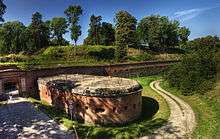Giżycko
Giżycko [ɡʲiˈʐɨt͡skɔ] (former Polish: Lec or Łuczany, German: ![]()
Giżycko | |
|---|---|
_ID_645478.jpg) Giżycko Castle, 14th century | |
 Flag 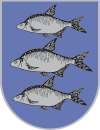 Coat of arms | |
 Giżycko  Giżycko | |
| Coordinates: 54°2′24″N 21°45′32″E | |
| Country | |
| Voivodeship | |
| County | Giżycko County |
| Gmina | Giżycko (urban gmina) |
| Established | 1335 |
| Town rights | 1612 |
| Government | |
| • Mayor | Wojciech Iwaszkiewicz |
| Area | |
| • Total | 13.87 km2 (5.36 sq mi) |
| Highest elevation | 142 m (466 ft) |
| Lowest elevation | 116 m (381 ft) |
| Population (2016) | |
| • Total | 29,642 |
| • Density | 2,100/km2 (5,500/sq mi) |
| Time zone | UTC+1 (CET) |
| • Summer (DST) | UTC+2 (CEST) |
| Postal code | 11-500 |
| Area code(s) | +48 87 |
| Car plates | NGI |
| Website | http://www.gizycko.pl |
Giżycko is a popular summer tourist destination due to its location within the Masurian Lake District and possesses numerous historical monuments, including a 14th-century Teutonic castle.
History
Antiquity and Middle Ages
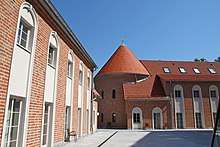
The first known settlements in the area of todays Giżycko were recorded in Roman times by Tacitus in his Germania and are connected to Amber Road in vicinity of which Giżycko was located.[1] A defensive settlement of the Prussians was known to exist in the area, and in IX was recorded as being ruled by king known as Izegup or Jesegup.[1]
After his failed attempt in 997 AD Bolesław I the Brave sent another expedition in 1008 to conquer/Christianize the Old Prussians. Just like St. Adalbert the missionary Bruno of Querfurt was killed by Sudovians near Lake Niegocin in 1009, and a memorial the Bruno – cross was erected near in 1910.
The Teutonic Knights built a castle in Prussia named Lötzen (Łuczany in Polish, later also Lec) in 1340, located at the isthmus between two lakes in todays [Masuria]]. Lötzen was administered within the Komturei of Balga.
After the outbreak of the Thirteen Years’ War in 1454, Łuczany sided with the Prussian League, aided by Poland.[2] The settlement was captured by the Teutonic Knights in 1455, but the Poles recaptured it the next year.[2] After the peace treaty signed in Toruń in 1466 until 1525 it continued in Teutonic Order State of Prussia, under Polish suzerainty as a fief.
Modern era
The settlement near the castle received town privileges, with a coat of arms and seal, in 1612, while part of the Duchy of Prussia (under Polish suzerainty till 1701). The first mayor was Paweł Rudzki. The Polish name of the town, used by its Polish speaking refugees to Prussia evangelical population,[3] at the time was Łuczany.[4]
Lötzen became part of the Kingdom of Prussia in 1701 and was made part of the province of East Prussia in 1773. In 1709/10 the plague claimed 800 victims, only 119 inhabitants survived.[5] In the 19th century, a new Lutheran church based on design by Karl Friedrich Schinkel was erected in the centre of the town. Lötzen became part of the German Empire in 1871 during the Prussian-led unification of Germany.
In June 1807, the Polish corps of generals Józef Zajączek and Jan Henryk Dąbrowski were stationed in the city. From 1875 to 1892 the Polish-language weekly newspaper Gazeta Lecka was published.[6][7]
1844–1848 the "Feste Boyen", a fortress named after the Prussian war-minister Hermann von Boyen, was built on a small landtongue between lake Mamry (Mauersee) and lake Niegocin (Löwentinsee). This fortress is one of the largest and best conditioned fortresses of the 19th century. In 1942–1945 it was the headquarters of the German military intelligence service (Fremde Heere Ost) under Reinhard Gehlen.
As a result of the treaty of Versailles, the 1920 East Prussian plebiscite was organized under the control of the League of Nations. During the preparations for the plebiscite, a German militia attacked a pro-Polish rally with around 1000 people. Speakers and people attending the rally were severely beaten; the main pro-Polish leader of the rally Fryderyk Leyk was beaten so badly that he just barely survived. Afterwards the attitude of Polish population in the town was resigned and part of the population boycotted the vote while others openly voted for Germany fearing revenge[8]; 4,900 votes were cast to remain in East Prussia, and therefore Germany, and none for Poland.[9] Afterwards aggressive Germanization was intensified , and during Nazi rule in Germany, there was practical ban on speaking Polish in public places in the town.[10]
In the 1930s Lötzen was the garrison of several military units of the Wehrmacht as a Sub-area Headquarter of Wehrkreis I, which was headquartered at Königsberg. Staff-, maintenance- and guardtroops of Hitler's headquarter Wolfsschanze and the Oberkommando des Heeres (OKH, army high command) were also based in or nearby Lötzen. The OKH was based at the Mauerwald area, ca. 10 km north of Giżycko, an undestroyed bunker system.
The town was occupied by the Soviet Union's Red Army in 1945 during World War II and placed under Polish administration after the war ended. The German-speaking populace who had not been evacuated during the war were subsequently expelled westward. The town was renamed Giżycko in 1946 in honor of the Masurian folklorist Gustaw Gizewiusz, a 19th-century Evangelical-Lutheran pastor in southern Masuria, who had greatly supported Polish language and Polish culture and stood against Germanisation of Masuria.
Demographics[11]
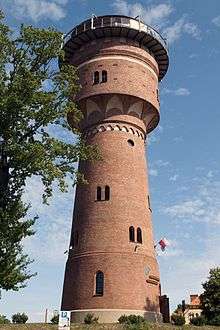
Up to 19th century, Polish population formed majority in the city, with small presence of Germans. By middle of 19th century German minority became much more numerous and Germanization made rapid progress in the city.[12]
| Year | Population |
|---|---|
| 1875 | 4,034 |
| 1880 | 4,514 |
| 1890 | 5,486 |
| 1925 | 10,552 |
| 1933 | 11,847 |
| 1939 | 14,000 |
| 2006 | 29,667 |
Sports
When Poland made the so far only international appearance in bandy, the city was represented.[13]
Education
Primary school
- Szkoła Podstawowa nr 4 im. I Dywizji Piechoty
- Szkoła podstawowa nr 5
- Szkoła Podstawowa nr 6
- Szkoła Podstawowa nr 7 im. Janusza Korczaka
Middle school
- Gimnazjum nr 1 w Giżycku im. Jana Pawła II
- Gimnazjum nr 2 w Giżycku im. Chwały Oręża Polskiego
- Katolickie Gimnazjum im. św. Brunona z Kwerfurtu
- Zespół Szkół nr 1 im. Mikołaja Kopernika
High school
- I Liceum Ogólnokształcące im. Wojciecha Kętrzyńskiego
- II Liceum Ogólnokształcące im. Gustawa Gizewiusza
- Zespół Szkół Elektronicznych i Informatycznych im. Komisji Edukacji Narodowej
- Zespół Szkół Kształtowania Środowiska i Agrobiznesu
- Zespół Szkół Zawodowych
- Katolickie Liceum im. św. Brunona z Kwerfurtu
College
- Medyczne Studium Zawodowe im. Hanny Chrzanowskiej
- Prywatna Wyższa Szkoła Zawodowa
Notable residents
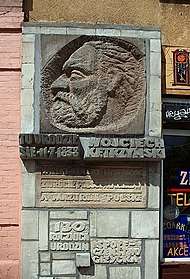
- Marcin Giersz (1808-1895) Masurian activist, publicist of Polish literature
- Gustaw Gizewiusz Gustav Gisewius (1810-1848) Prussian Masurian pastor, folklorist, and translator
- Wojciech Kętrzyński (1838–1918), Polish historian and activist
- Paul Davidson (1867–1927), German film producer
- Jan Bułhak (1876–1950), Polish pioneer of photography in Poland
- Franz Pfemfert (1879–1954), German publisher
- Lothar Gall (born 1936), German historian
- Łukasz Broź (born 1985), Polish footballer
- Marcin Budziński (born 1990), Polish footballer
- Jakub Kochanowski (born 1997), Polish volleyball player, 2018 World Champion
International relations
Twin towns — Sister cities
Giżycko is twinned with:
Gallery
 Bruno of Querfurt Hill and Cross in Giżycko. View from Lake Niegocin
Bruno of Querfurt Hill and Cross in Giżycko. View from Lake Niegocin Boyen fortress
Boyen fortress- Swing bridge and the castle
 Music school
Music school Evangelical church
Evangelical church- Town hall
References
- History Giżycko City official website
- Słownik geograficzny Królestwa Polskiego i innych krajów słowiańskich, Tom V, Warsaw, 1884, p. 113
- Słownik geograficzny Królestwa Polskiego i innych krajów słowiańskich, Tom V, Warsaw, 1884, p. 114
- Jan Leo, Dzieje Prus. Z braniewskiego wydania roku 1725 przełożył bp Julian Wojtkowski, Olsztyn, 2008, p. 581
- Kossert, Andreas (2006). Masuren. Ostpreußens vergessener Süden (in German). Pantheon. ISBN 3-570-55006-0.
Kossert, Andreas (2004). Mazury, Zapomniane południe Prus Wschodnich (in Polish). ISBN 83-7383-067-7. - Leon Sobociński, Na gruzach Smętka, wyd. B. Kądziela, Warsaw, 1947, p. 76
- "„Gazeta Lecka" - Encyklopedia PWN - źródło wiarygodnej i rzetelnej wiedzy". encyklopedia.pwn.pl (in Polish). Retrieved 2020-03-14.
- Giżycko: z dziejów miasta i okolic Irena Berentowicz, Andrzej Wakar - 1983 p.126
- Marzian, Herbert; Kenez, Csaba (1970). Selbstbestimmung für Ostdeutschland – Eine Dokumentation zum 50 Jahrestag der ost- und westpreussischen Volksabstimmung am 11. Juli 1920 (in German). p. 80.
- Giżycko: z dziejów miasta i okolic Irena Berentowicz, Andrzej Wakar - 1983 p.126
- Deutsche Verwaltungsgeschichte Provinz Ostpreußen, Kreis Lötzen
- Giżycko: z dziejów miasta i okolic Irena Berentowicz, Andrzej Wakar - 1983 p.123
- Bandy 2006, World Championships
- Co Giżycko łączy z Ghazni? Archived 2013-11-11 at the Wayback Machine
External links
| Wikimedia Commons has media related to Giżycko. |
- Municipal website
- Tourism website
- 1882 Map of East Prussia with Lötzen between Lakes Mauer & Löwentinsee
- Full text of "Monumenta historiæ Warmiensis, oder, Quellensammlung zur Geschichte Ermlands"
- festeboyen.pl (Polish)
